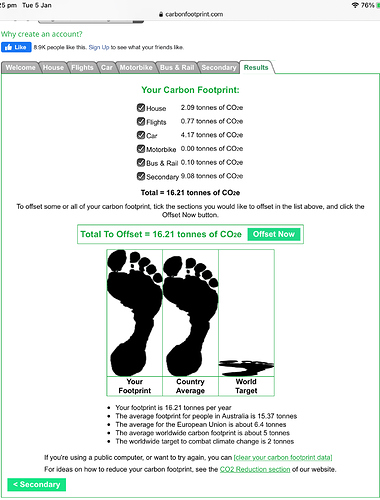There have been a number is recent TV programs with a focus on reducing our individual contributions to Green House Gas (GHG) emissions. Typically the carbon footprint is measured in Tonnes of Carbon Dioxide. Other harmful GHG’s, EG methane (CH4) and nitros oxides (NOx) are converted to the equivalent in CO2 based on impact. IE - CO2e is often how this is written.
@gordon recently noted Australia creates more than 17 tonnes CO2e for every one of us.
The ABC recently provided,
There are links to two tools to assist in calculating a personal ‘Carbon Footprint’. I’ve tried both.
They provided very different outcomes. I had difficulty distinguishing between whether the result was for one or two for the first trialed. It seems as if it is for one only. The second I clearly used data for two people hence it is the the total footprint of two combined in the one household.
There are links for each in the ABC article.
5.7t CO2e seems to be heading in the right direction?
The second provided more useful information and a higher estimate.
As this is for two 16.2/2 = 8.1 tonnes CO2e each seems a little more realistic.
Are there better tools out there and what are your experiences using any?
Observations:
Neither tool properly accounted for our solar PV. We export more than twice what we import, hence better than carbon neutral. I did not expect either to account for our carbon sink from our small project at native forest regeneration.
I was surprised at the size of the footprint from our transport choices, and consumption. Food, clothing, household items etc. More than 60%. As we purchase a large portion of our food local a large improvement needs our retailers and manufacturers to also step up. Perhaps the more we purchase second hand and re purpose the less the carbon cost?

